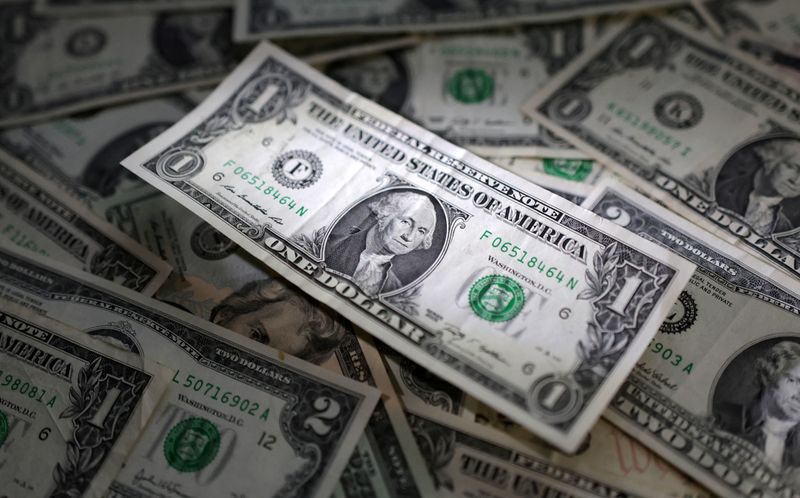NEW YORK (Reuters) -The dollar gained on Thursday despite a soft U.S. producer price inflation report for May, after the Federal Reserve adopted a hawkish tone at the conclusion of its meeting on Wednesday.
Data on Thursday showed that U.S. producer prices unexpectedly fell in May, with the headline producer price index (PPI) dropping 0.2% last month after advancing by an unrevised 0.5% in April. Core prices were flat, after also seeing a 0.5% increase the prior month.
It comes after May’s U.S. consumer price index (CPI) on Wednesday was softer than economists had expected, prompting a sharp sell-off in the greenback.
Combined, the CPI and PPI releases make it likely that Personal Consumption Expenditures (PCE), the Fed’s preferred inflation measure, will also show softening price pressures.
“Today’s PPI comes on the heels of a softer than expected CPI … which is going to feed into what probably is going to be a somewhat softer core PCE deflator when we get it at the end of the month,” said Marc Chandler, chief market strategist at Bannockburn Global Forex in New York.
But optimism over cooling inflation was not enough to keep the dollar down.
The U.S. currency rebounded after Fed officials on Wednesday unexpectedly forecast only one interest rate cut this year and pushed out the start of rate cuts to perhaps as late as December.
Fed Chair Jerome Powell said policymakers were content to leave rates where they are until the economy sends a clear signal that something else is needed – through either a more convincing decline in price pressures or a jump in the unemployment rate.
Other data on Thursday showed that the number of Americans filing new claims for unemployment benefits increased to a 10-month high last week.
The dollar index was last up 0.49% at 105.20. It reached a four-week high of 105.46 on Tuesday, before dropping as much as 1% after Wednesday’s CPI data.
“It was a bit overdone, the reaction (to) that CPI. It was almost a relief that it wasn’t worse. And that’s what sparked such a strong knee-jerk reaction,” said City Index market strategist Fiona Cincotta.
Traders had pared bets that the Fed will cut in September after Friday’s employment report for May showed more jobs growth than expected, while wages also rose more than was anticipated.
Those bets were revived, however, after Wednesday’s CPI report.
Fed funds futures traders now see two cuts this year as likely, with a first cut in September seen as a 68% probability, according to the CME Group’s FedWatch Tool.
The dollar is likely to remain supported as Fed policy contrasts with more dovish international central banks.
“I’m not convinced that the dollar’s top is in place on this move,” Chandler said. “We might not be yet at the maximum policy divergence.”
The European Central Bank and the Bank of Canada have begun cutting rates, and may cut again before the Fed begins easing.
Uncertainty over European elections is also likely to hurt the euro against the greenback.
“This political uncertainty in Europe is sufficient to keep the dollar bid,” Chandler said.
Far-right parties gained ground in European Parliament elections on Sunday, prompting French President Emmanuel Macron to call a snap election in his country.
The euro was last down 0.65% at $1.0739. It fell as low as $1.07195 on Tuesday, the lowest since May 2, before jumping as high as $1.08523 on Wednesday as the dollar weakened.
The yen also fell before the Bank of Japan concludes its two-day meeting on Friday when it will consider trimming its bond buying, taking a first key step to reducing its almost $5 trillion balance sheet.
The yen in particular has suffered from the wide divergence between Japanese and U.S. interest rates.

The dollar was last up 0.11% at 156.89 yen.
In cryptocurrencies bitcoin fell 1.86% to $66,801.
To read the full article, Click Here

